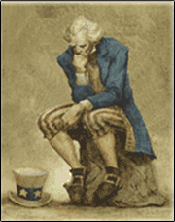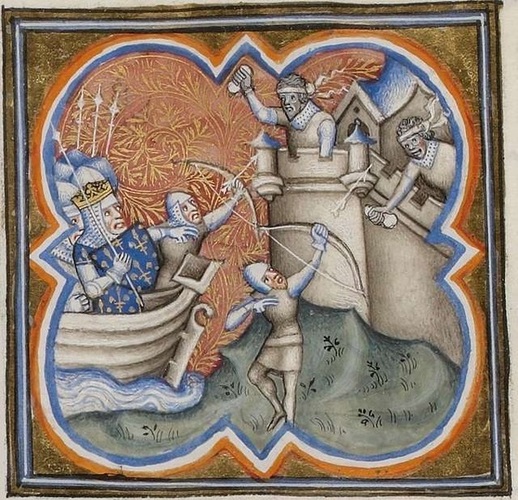
–>
July 12, 2022
Today in history, the important fortress city of Acre fell back to Crusader hands, and in so doing ushered in the Third Crusade, arguably the most bloody and violent of all crusades.
‘); googletag.cmd.push(function () { googletag.display(‘div-gpt-ad-1609268089992-0’); }); }
Following the decisive battle of Hattin in 1187, Sultan Saladin went on to conquer Jerusalem and most other Christian kingdoms, including coastal Acre. Elated by his success, he vowed not only to eliminate all Crusaders from the Holy Land, but to invade Europe and “pursue the Franks there, so as to free the earth of anyone who does not believe in Allah, or die in the attempt.”
Before long, however, and due to its strategic location, Acre became the rallying point for the remaining Crusaders. If only they could reclaim it, they could reconsolidate their power base and spread out again, including to Jerusalem. So they laid it to siege in the summer of 1189. Famine, plague, and pestilence harried the Crusaders and countless thousands died while the Muslims continued to hold out in Acre.
The mood changed in the summer of 1191, when Philip II of France and especially Richard I of England — the Lionheart, whom most Crusaders looked to as the natural leader — arrived with their men to aid in the siege.
‘); googletag.cmd.push(function () { googletag.display(‘div-gpt-ad-1609270365559-0’); }); }
Richard immediately ordered the construction of more moveable war towers; more ditches around Acre were filled, thereby allowing these new engines of war to encroach upon and bombard the city; and defensive trenches were dug around the Crusaders’ camp, to prevent sorties from Saladin’s marauding troops.
Soon all the engines of war rained down death dealing destruction. Massive boulders — some aflame and setting anything inside Acre not built of stone ablaze — rocked the city. After the battle of Hattin, Saladin had ordered the ritual massacre of the military orders of the Knights Templars and Hospitallers. Now their brothers-in-arms made their presence felt: “the Templars’ stonethrower wreaked impressive devastation,” wrote a contemporary, “while the Hospitallers’ also never ceased hurling, to the terror of the Turks.”
In the words of Muslim chronicler Ibn al-Athir, after Richard’s arrival, “The damage they did to the Muslims increased greatly. The king was the outstanding man of his time for bravery, cunning, steadfastness and endurance. In him the Muslims were tried by an unparalleled disaster.”
Before long, however, Muslim spies “reported the great fatigue they [the Crusaders] endured on account of all the various tasks they had constantly to put up with since the arrival of the accursed king of England. Then the latter fell seriously ill and was on the verge of death.”
More robust than most men, even Richard had succumbed to the pestilent camp and contracted a form of scurvy which caused hair and fingernails to fall out, and in extreme cases, blindness. Even so, he continued inciting his men to war from the sickbed.
A contemporary chronicle offers a snapshot of these times:
‘); googletag.cmd.push(function () { googletag.display(‘div-gpt-ad-1609268078422-0’); }); } if (publir_show_ads) { document.write(“
King Richard’s stonethrowers hurled constantly by day and night… [O]ne of them killed twelve men with a single stone. That stone was sent for Saladin to see, with messengers who said that the diabolical king of England had… [come] to punish the Saracens. Nothing could withstand their blows; everything was crushed or reduced to dust. Yet the king was confined to bed suffering from a severe fever, completely wretched because he saw the Turks insolently challenging and attacking our people with increasing frequency but he could not engage them in battle because he was ill.
 This, the chronicler adds, is what truly “burned” him up — for Richard “suffered more torture from the insolent Turkish raids than from the burning fever.”
This, the chronicler adds, is what truly “burned” him up — for Richard “suffered more torture from the insolent Turkish raids than from the burning fever.”
All this time Saladin had also been resorting to terror tactics, for he “enrolled 300 robbers from amongst the thieving Bedouin to infiltrate the enemy.” Baha’ al-Din explains how, after a day of exhaustive fighting, these cutthroats would slip into the Crusader camp during the thick of night. The common soldier would be rudely awoken “by a dagger which was held at his throat.” He and his belongings would then be spirited away or, if he resisted, slaughtered on the spot.
In time, Richard, though still sick, had become even more sick of his impotence. He ordered his moveable tower hauled into “the ditch outside the city wall”; he then “had himself carried out” on his sickbed and placed near his “most skilled crossbowmen” under the tower. The wounded warrior-king did this “to discourage the Saracens with his presence and encourage his own people to fight. There he used his crossbow, with which he was skilled, and killed many.”
Meanwhile, “the Christians’ stonethrowers kept up a constant battering of the walls, day and night.” Acre was holding on by a thread. Although the Christian chronicler praised the martial spirit of its Turkish garrison — they were “fit and ready for anything” and “certainly not inferior to our people” — by now many Muslims “hurled themselves from the walls at night in a desperate attempt to escape.” On being captured, a “great many of them begged to be given the sacrament of the Christian baptism,” though, as the chronicle observes, “they asked for this more as a means of escape.”
Finally, on July 12, 1191, and considering that large sections of Acre’s walls had by now collapsed into and filled the moat, “the Franks — Allah curse them! — conquered the city of Acre,” writes Ibn al-Athir, nearly two years since the siege first began.
Now that they had re-established themselves in the Holy Land, and the Third Crusade was off to a good start, would the Crusaders, under the Lionheart’s leadership, be able to liberate Jerusalem from Islamic control? That is another, even more fascinating story.
This article was abstracted from Raymond Ibrahim’s new book, Defenders of the West: The Christian Heroes Who Stood against Islam, which features a chapter on Richard Lionheart. Ibrahim is a Shillman Fellow at the David Horowitz Freedom Center, a Judith Rosen Friedman Fellow at the Middle East Forum, and a Distinguished Senior Fellow at the Gatestone Institute.
Image: Picryl
<!– if(page_width_onload <= 479) { document.write("
“); googletag.cmd.push(function() { googletag.display(‘div-gpt-ad-1345489840937-4’); }); } –> If you experience technical problems, please write to [email protected]
FOLLOW US ON
<!–
–>
<!– _qoptions={ qacct:”p-9bKF-NgTuSFM6″ }; ![]() –> <!—-> <!– var addthis_share = { email_template: “new_template” } –>
–> <!—-> <!– var addthis_share = { email_template: “new_template” } –>





